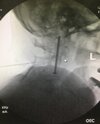- Joined
- May 8, 2004
- Messages
- 4,008
- Reaction score
- 1,639
what level is your cut off for interlaminar CESI
I don't go above C6-7, always been told the ligament may not be fused above this level for safe CESI
interesting article here: "RESULTS: Our most common spinal level for injection was C5-6, followed closely by C6-7. Hundreds of injections were performed at spinal levels above C5-6 with the most cephalad level C2-3."
I don't go above C6-7, always been told the ligament may not be fused above this level for safe CESI
interesting article here: "RESULTS: Our most common spinal level for injection was C5-6, followed closely by C6-7. Hundreds of injections were performed at spinal levels above C5-6 with the most cephalad level C2-3."



